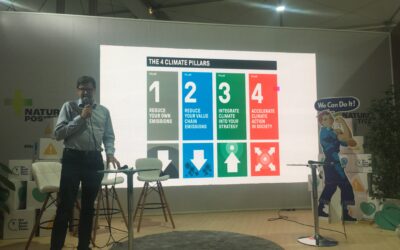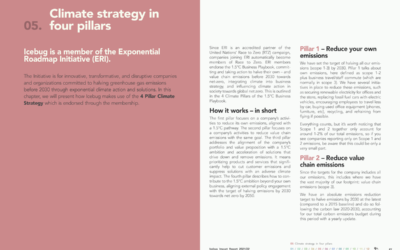As set by Net Zero standards and the Race to Zero, our initial focus is on reducing and avoiding emissions across the value chain as well as on investing in renewable energy. As a last resort to address any unavoidable emissions, we will work to remove remaining emissions from the atmosphere through approved carbon removal credits. Our strategy reflects the 4 Climate Pillars of the 1.5°C Business Playbook, which Ericssson co-initiated and authored in 2020.
Reducing own emissions
At Ericsson we are dedicated to walking the talk. Even though our own activities stand for less than 0.5% of our carbon footprint, we can influence our direct emissions faster, and have set a steep reduction trajectory to reach Net Zero emissions in own activities by 2030.
To achieve this, we are working towards procuring 100% renewable energy for our facilities. Today, 62% of all our energy purchased is from renewable energy – 67% if counting only electricity. We aspire to have an electric fleet where possible, cap business travel to 50% pre-pandemic levels and reduce emissions from commuting and teleworking. Any residual emissions they can’t reduce by 2030 they will need to remove in like for like emissions, following the ITU standards for Net Zero value chains. As of 2021, we achieved a 60% reduction of emissions from our own activities (from a 2016 baseline).
Reducing value chain emissions
In 2021, Ericsson set a new value chain target to reach Net Zero emissions by 2040, including reducing emissions by 50% in the portfolio and supply chain. To support the supply chain emissions reductions, Ericsson works with product design, material choices and directly with suppliers. We have set a supplier climate target for 350 of our high emitting and strategic suppliers – responsible for 90% of Ericsson’s supply chain emissions – to set their own 1.5°C aligned climate targets. As mid-year 2022, 198 suppliers, 58 of those high emitting, had set such targets.
Energy use in network operation remains a priority for Ericsson and our customers. Our research shows that the lifetime energy usage from Ericsson’s delivered products remains a major contributor to our carbon footprint (over 90%). Increased energy performance of Ericsson’s products and solutions is a key enabler to lower customers’ total cost of ownership and network related carbon footprint.
We are committed to developing innovative products and solutions that enable the mobile industry to meet current and future traffic demands while simultaneously addressing energy consumption. That’s the driving force behind our holistic network level approach, ‘Breaking the energy curve’, which supports the important energy reduction efforts that are integral to Ericsson’s and our customers’ Net Zero journeys.
“The 1.5°C Business Playbook is a framework for company strategy and action, that we use, to help our supply chain business partners to set 1.5°C aligned targets. We need all companies to be bold and join this journey towards a more sustainable and connected world,” Börje Ekholm, CEO, Ericsson
Integrating climate in business strategy
Through decades of life cycle assessments and research on the impact of the ICT sector, we understand what digitalization and technology can do to reach Net Zero and positively transform society. According to Ericsson´s peer-reviewed research, ICT solutions have the potential of enabling 15% emission reductions across industries by 2030, while being responsible for only 1.4% of the global carbon footprint. It is therefore important to get this message and these solutions out to the world, enabling digitalization to be a part of the solutions. Even though we know the potential, if it is unused, we will not be able to decarbonize sectors in the pace that is needed to first halve our emissions by 2030 or reach Net Zero before 2050.
Throughout our history, sustainability targets have been driven by the Sustainability and Corporate Responsibility units. However, target drivers and reduction potential are always dependent on respective business areas and have been key success factors for driving down emissions. When setting the new Net Zero ambition, it was then apparent that the drivers needed to be each respective Business Area. Incorporating targets and following them is a continuous process which we are working on each day.
Influencing climate action in society
We partner with academia and businesses to support global action for the 1.5°C ambition. In 2018 and 2019, Ericsson was an active lead partner with other leading organizations in the development of the Exponential Roadmap, which showed 36 solutions that exist today and could support the halving of global emissions by 2030.
Furthermore, as part of our supply chain commitment, Ericsson founded the 1.5°C Supply Chain Leaders together with other leading companies and the Exponential Roadmap Initiative. The group works together to drive climate action throughout global supply chains in line with science and supports small and medium-sized enterprises in accelerating climate action through the SME Climate Hub. As part of the 1.5°C Supply Chain Leaders, Ericsson was a key driver in the launch of the 1.5°C Supplier Engagement Guide, a collaborative platform to engage with suppliers to halve greenhouse gas emissions before 2030.
_____________________
[1] SBT between 2016 and 2022 for own activities includes: Scope 1 and 2 emissions as well as scope 3 categories business travel and downstream product transportation. For Net Zero own activities, product transportation is excluded and commuting & teleworking is included instead.
[2] Carbon dioxide removal, also known as negative CO2 emissions, is a process in which carbon dioxide (CO2) is removed from the atmosphere and locked away for long periods of time. To reach Net Zero in the value chain, companies can neutralize their residual emissions that cannot be further reduced, by means of specific removal trustworthy technologies that adhere to global standards





